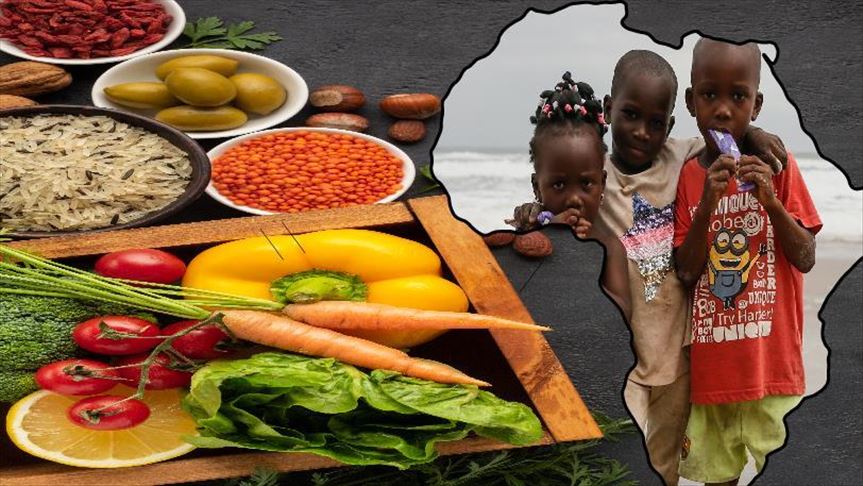
KIGALI, Rwanda
Nutritionists and policy makers agree that Africa has enormous potential to address malnutrition because of the continent’s exceptional natural resources coupled with rapid economic growth, says an expert from the UN.
Global absolute number of people affected by chronic food deprivation began to rise in 2014 from 775 million people to 821 million in 2017, according to the Global Food and Nutrition Service report by a U.S.-based organization Results for Development.
The report indicates that there is a significant burden of malnutrition in 140 countries across the globe.
According to Mphumuzi Sukati, Senior Nutrition and Food Systems Officer at the UN’s Food and Agriculture Organization (FAO), worsening food and nutrition services situation in Africa deteriorated in 2017 in parts of sub-Saharan-Africa, South-Eastern Asia and Western Asia due to conflict compounded by drought episodes of El Nino phenomenon, a climate phenomenon which raised temperatures in the equatorial Pacific region.
Sub Saharan Africa’s share of undernourished people increased, while there was a continued decline in Asia in the same period, said Sukati.
The situation is dire in Eastern Africa, where one-third of the population is estimated to be undernourished, he added.
At the 4th conference of the Federation of African Nutrition Societies in the Rwandan capital Kigali this week, Sukati advised countries to adopt good policies and multi-stakeholder approaches such as nutrition-sensitive agriculture to address malnutrition.
With political commitment, Africa can reverse high levels of malnutrition because the continent has exceptional natural resources coupled with rapid economic growth, he says.
Andrew Prentice, a nutrition expert, says it is important for African countries to halve food losses and waste, working with global communities to resolve nutritional deficiencies.
In Ethiopia over 20% of the total crop yield is reportedly lost to poor post-harvest handling, according to FAO.
For Jack Clift, program director at Results for Development, there is need for more money to be allocated to nutrition which should be directed to those who need it the most.
Calling for collective effort from all partners in the fight against malnutrition, Clift notes that investing in nutrition is critical for health and economic development.
An estimated 151 million children under age 5 globally are developmentally stunted as a result of chronic undernourishment, he said.
He underlines that malnutrition is directly or indirectly tied to up to 60% of child deaths and drastically affect childhood development.
The economic consequences represent losses of 11% of GDP every year in Africa and Asia, whereas "preventing malnutrition delivers $16 in return on investment for every $1 spent", he says.
In the run-up to the 2020 Nutrition for Growth Summit in Tokyo, experts contend that more investment towards nutrition is needed across the board in order for countries to meet the World Health Assembly targets of reducing stunting by 40% by 2025.
The key to improvement of nutrition and public health at his organization has been through developing and promoting biofortified food crops that are rich in vitamins and minerals, said Erick Boy-Gallego, the head of nutrition unit at HarvestPlus, a Washington-based International Food Policy Research Institute.
Anita Asiimwe, the coordinator of Rwanda’s National Early Childhood Development Program, says good nutrition has a positive impact on the child's physical growth and intellectual development, which lays foundation for a future healthy and productive adult individual.
A healthy and well-nourished population is a necessity for any country to achieve sustainable social-economic development, she says, noting that in particular, the nutritional status of children is a strong indicator of the community's development in a nation.
- Success stories
In Namibia, stunting fell from 37% to 13% between 2007 and 2003 while in Rwanda it declined from 51% in 2010 to 38% in 2015 among under five-year-old children, according to the Global Food and Nutrition Service report.
A four-day meeting due to close on Thursday, organized by FANUS with the theme of "Nutrition in Action for Sustainable Development in Africa", presented results on child stunting as a major public health concern across Sub-Saharan African countries.
Survey results presented at the meeting indicate that despite the challenges, in Ghana stunting declined from 20% to 13% between 2008 and 2014 while in Kenya, it declined from 33% to 23% in 2008-2013.
The Rwandan government has undertaken various initiatives aimed to tackle malnutrition in the country, which is as one of the major challenges especially in rural areas.
The initiatives highlighted by the prime minister’s office include distribution of free fortified flour to vulnerable children and expectant mothers, engaging community health workers to mobilize parents to treat malnourished children and awareness campaigns on breastfeeding.
Other initiatives include maintaining focus on cattle stocking program dubbed one-cow-per poor family, as well as educating parents on how to prepare balanced diet for their children.
The initiatives form an integral part of the National Early Childhood Development Program.
Ngozi Nnam, president of Federation of African Nutrition Societies (FANUS), thinks one of the factors inhibiting malnutrition fight in Africa is that people holding nutrition positions are not nutritionists.
FANUS is an umbrella of nutrition societies of African countries with vision to market, sustain and improve nutrition security on the continent.





